Raita and Aiichiro Fujiyama, and the Fujiyama Memorial Hall
From the Hiyoshi Campus main gate, if you go up the slope, take a left, and go a short way further, the Fujiyama Memorial Hall will appear on your right. This beautiful building, with its red brick divided by exposed concrete pillars, was constructed to memorialize the achievements of—and takes its name from—a leader of industry in Japan throughout the Meiji, Taisho and the start of the Showa eras.
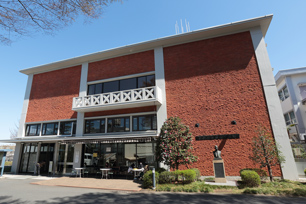
A bronze bust of Raita Fujiyama sits in front
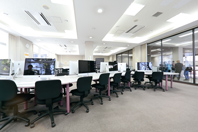
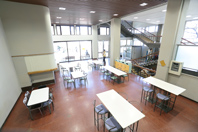
The Fujiyama Memorial Hall stands right across from the Hiyoshi Campus University Co-op Store. There must be countless students who, over the years, have used the computer rooms and study rooms within these walls. Originally, this building opened in 1958 as the Fujiyama Memorial Library. The name derives from Raita Fujiyama, a Keio alumnus and the founder of the private library in Shirokanedai that preceded it—the Fujiyama Industrial Library.
Raita Fujiyama, a player in the Business World: Founding a Special Library to Cement Japan as an Industrial Nation
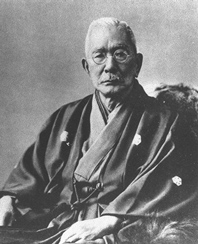
Fujiyama was born in Matsuura-gun in Hizen Province (modern-day Imari City, Saga Prefecture), to the village headman and a feudal retainer of the Saga Domain. After studying at the Kodokan (a school of the Saga Domain), he studied at the Nagasaki Normal School (a school of education). When he graduated, he took jobs teaching there and at an elementary school. From 1884 he studied at Keio Gijuku, and after a stint back in his hometown as a member of the prefectural assembly, he turned his attention to the business world. In 1892, he was introduced to Yukichi Fukuzawa’s nephew, Hikojiro Nakamigawa, who was known as the "Restorer of Mitsui," and Fujiyama began working at Mitsui Bank. Fujiyama quickly distinguished himself, and exhibited his abilities in management when he was sent from the bank to work at Shibaura Seisakusho (now known as Toshiba) and Oji Seishi. After resigning from Mitsui in 1909, he was hired as president of Dai-Nippon Seito, which he saved from the brink of bankruptcy. Through acquisitions and founding of new companies, he formed a group of companies which was known as the Fujiyama Konzern Group.
At Keio, he began serving as a Councillor from 1905, and he contributed greatly to the development of the school over the course of his life, such as through conducting surveys and research as a special committee member for the establishment of the present School of Medicine.
Laying the Foundation of Japan’s Engineering Education, Together with the Fujiwara Institute of Technology
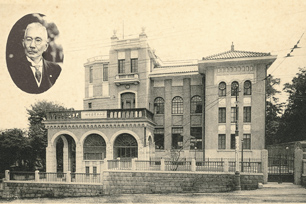
A photo of the Fujiyama Industrial Library (From the Chuo City Library collection)
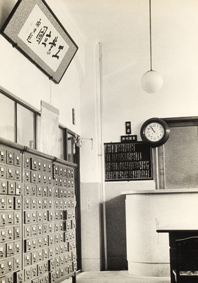
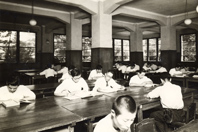
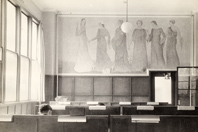
The calligraphy is clearly visible with the words that Fujiyama Raita strove for: “Industrial Nation.” (From the Fukuzawa Memorial Institute for Modern Japanese Studies collection)
The Fujiyama Industrial Library mentioned earlier in this article was opened by Fujiyama in 1927 with money invested from his own personal fortune. He collected magazines related to engineering from all over the world, and the total volumes amassed numbered well over 50,000. With a state-of-the-art reference service, including quick reference summaries of articles in foreign magazines and a Japanese translation index, it was pioneering for Japanese libraries at the time.
After Fujiyama died in March of 1944, the library, including the entire collection, the building, and the land on which the building stood, was donated to Keio by his son, Aiichiro. That same year in August, Keio alumnus Ginjiro Fujiwara donated the Fujiwara Institute of Technology, which he founded, to Keio University, and the Faculty of Engineering (now the Faculty of Science and Technology) was inaugurated. Thus, a fully-fledged advanced engineering education was launched, which had at its foundation the Fujiyama Industrial Library.
After the war, due to the requisition of Hiyoshi Campus by the US Army, the Faculty of Engineering was forced to move around, and it was difficult frequently being forced to move from one temporary school building to another. In 1949, the Faculty of Engineering finally settled down in Koganei, but the location of the library in Shirokanedai was too far for many people, and visitor numbers plummeted. In 1957, with Aiichiro Fujiyama's consent, Keio sold the land and building. The building that was completed with the proceeds from the sale opened the next year as the Fujiyama Memorial Library, which was replete with general books, not just volumes on engineering. It later became the Fujiyama Memorial Hall.
Aiichiro Fujiyama and his Lost Collection

Following in his father's footsteps, Aiichiro also made great contributions to Keio as a Keio alumnus. (He withdrew from the present Department of Political Science, Faculty of Law for medical reasons, but was later named a Keio Alumnus by special selection.) Besides his generous donations and his service as the president of the Mita Liaison Club, which aimed for the early release of the Hiyoshi Campus from requisition, we cannot forget the now-lost Fujiyama Collection.
After the war, Aiichiro, as a member of the House of Representatives, worked eagerly on repairing the diplomatic relations with China, and became known as a collector of valuable materials concerning China. This magnificent collection of more than 4000 books and documents was known simply as the Fujiyama Collection of Modern China, and it was to be donated to Keio on the opening of the Mita New University Library. Unfortunately, in February 1982, just two months before the planned opening of the New University Library, a fire broke out at the Hotel New Japan in Nagatacho where Aiichiro’s office was. The entire collection was also engulfed and lost in the flames.
*Photographs used in the article are preserved by the Fukuzawa Memorial Center for Modern Japanese Studies.
